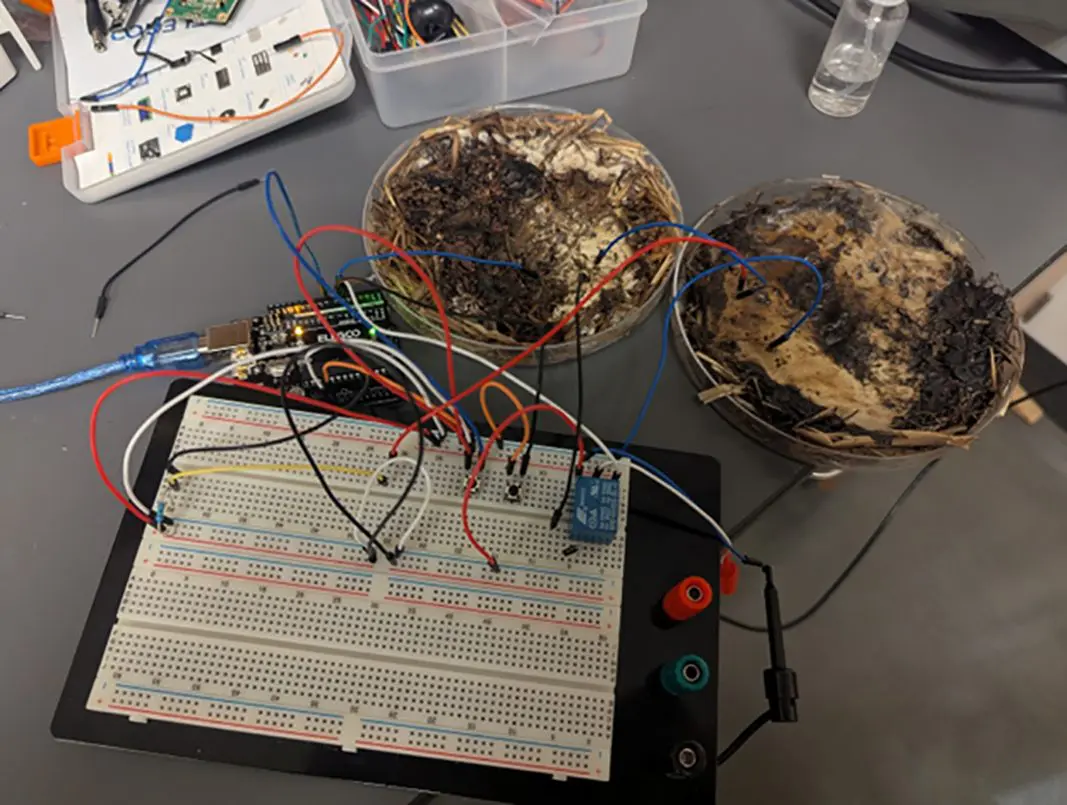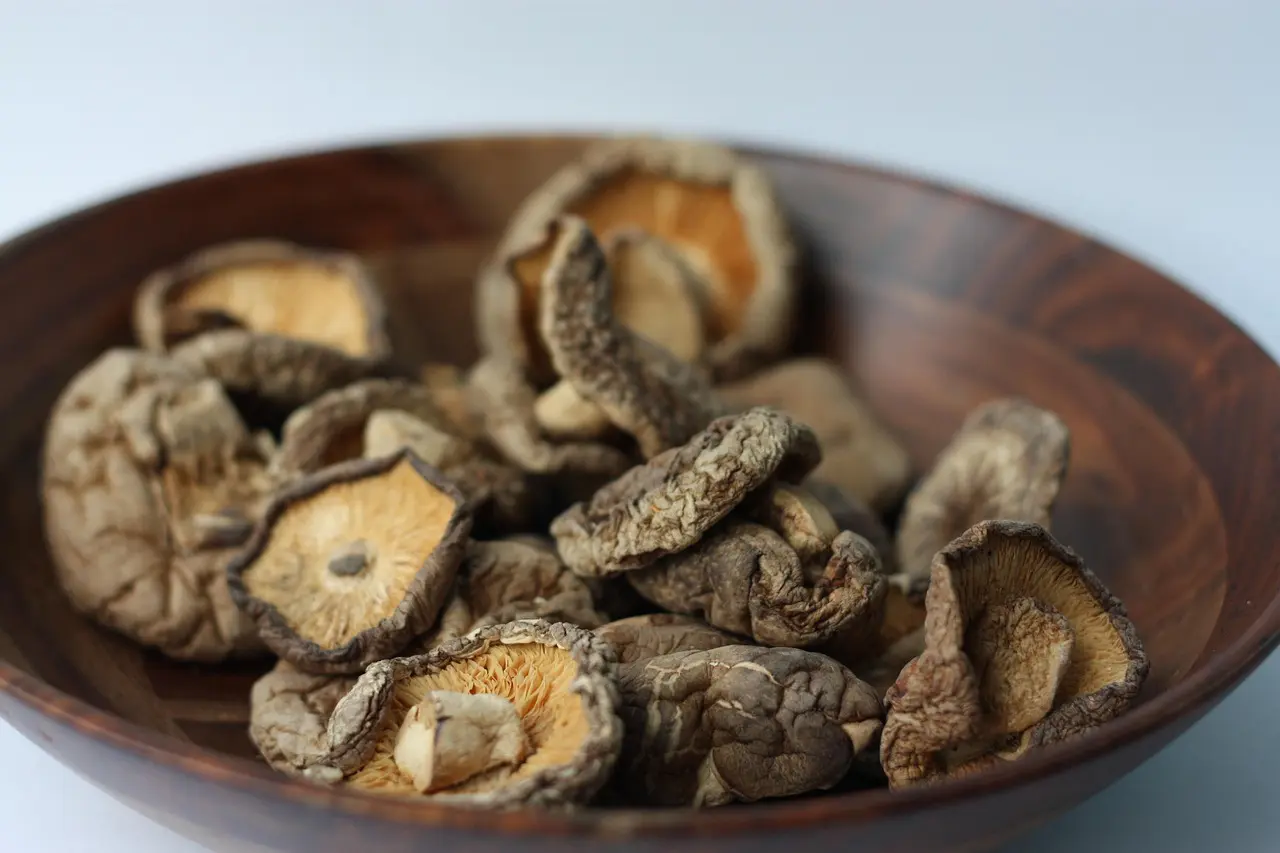You probably didn’t expect to read this today: the same kind of mushroom you slice into a stir fry may one day run your computer.
And yes, I am as baffled as you are. And also yes, as my husband works in IT, I instantly told him about this new discovery.
So, what is this all about?
Researchers at The Ohio State University have built working electronic memory components – the pieces of hardware computers use to store and process data – out of common, edible mushrooms like shiitake.
They argue that fungal tissue could become the core of “living computers”: biodegradable, brain-like machines that learn, remember, and compute using biology instead of mined metals.
Yes, seriously.
If this sounds like science fiction (“mushrooms are going to replace silicon chips”), let’s walk through it step by step.
Because if this holds up, it’s not just a cute lab trick. It could change how we build AI, how we store data in harsh environments like space, and how we deal with e-waste on Earth.
What exactly did they build with mushrooms?
Photo source: doi: https://doi.org/10.1371/journal.pone.0328965.g004 from the original stydy, quoted inside the article – https://journals.plos.org/plosone/article?id=10.1371/journal.pone.0328965
The team at The Ohio State University built a working “memristor” – a type of electronic component that can store and recall its previous electrical state – out of shiitake mushroom mycelium.
Simply said, a memristor is like a tiny artificial synapse: it remembers what signals it has seen, even after the power is off. That’s the basic ingredient you need for brain-inspired (neuromorphic) computing, where hardware learns and adapts the way neurons do instead of just following rigid instructions. (LaRocco et al., 2025; The Ohio State University, 2025)
Here’s how they did it, in simple terms:
- Grow the mushrooms. They cultivated common edible shiitake mushrooms and let them develop dense mycelium networks — basically fungal “wiring.”
- • Prepare the material. They then preserved that network by dehydrating it, so it could be handled and tested like a physical component instead of a living culture. Crucially, the dehydrated samples still behaved like memristors when stimulated. (LaRocco et al., 2025)
- Wire it up. The team connected electrodes to the fungal material and sent controlled signals through it, watching how its electrical resistance changed.
- Test for memory. The fungal samples didn’t just pass current – they showed memristive behavior. In other words, they “remembered” their previous state. The device kept operating at frequencies up to about 5.85 kHz with around 90% accuracy, which the authors say is fast enough to matter for edge computing and even radiation-heavy environments like space. (LaRocco et al., 2025)
In plain English: this wasn’t just a cute biology stunt. The mushroom material acted like a real, programmable computer component.
One of the study authors described these devices as “fungal memristors” and suggested they “could be ideal interfaces for high-frequency bioelectronics.” (The Ohio State University – News – see the first link in this article, October 24, 2025).
Wait – are we talking about an actual mushroom computer?
Kind of, but not like a mushroom laptop you can sauté if it crashes. Sorry, I couldn’t help myself 😀
Think of it more like this:
Today’s chips = carved from silicon + doped with rare and difficult-to-source elements.
Tomorrow’s biochips (what this research points to) = grown like crops, then processed, dried, wired, and used as computing elements.
This is a materials breakthrough. The team didn’t write a full operating system that runs on portobellos. They showed that fungal tissue can act as memory and logic at a hardware level. That’s the first domino.
Why does that matter? Because memristors are one of the core building blocks for next-generation AI hardware.
Neuromorphic systems – the class of computing that tries to act more like a brain than a traditional chip – don’t just crunch numbers. They learn, adapt, and change their own internal state the way biological synapses do.
The Ohio State team argues that fungi are a surprisingly good physical match for that goal: mycelium networks can transmit electrical signals, adapt under stress, and reroute around damage, the same way living neural tissue finds new pathways. In other words, mushroom tissue isn’t just biodegradable – it’s structurally and functionally compatible with brain-like computing. (LaRocco et al., 2025)
Why are scientists so hyped about this?
Three big reasons: sustainability, resilience, and edge computing.
Sustainability: no rare earths, less e-waste
Traditional semiconductors rely on rare-earth materials and energy-intensive extraction processes. Fungal memristors, by contrast, are grown, not mined. They’re biodegradable and low-cost, built from renewable organic matter instead of toxic or limited elements.
The Ohio State University team describes their approach as a step toward “eco-friendly, low-cost computing hardware” that could reduce electronic waste and dependence on critical minerals. (LaRocco et al., 2025; The Ohio State University, 2025)
Resilience in extreme environments
One surprising finding: dehydrated shiitake-based devices continued to operate at high frequencies and displayed resistance to radiation. The researchers point out that shiitake’s natural cellular compounds, such as lentinan, may help it withstand oxidative stress, making the material potentially useful for aerospace or other radiation-heavy settings. (LaRocco et al., 2025)
Translation? Mushrooms could literally go to space.
Smarter “edge” devices
Edge computing means running AI and logic locally – on a drone, wearable, or sensor – rather than constantly relying on the cloud. Because fungal memristors consume very little power and can adapt to changing input, they could enable self-learning sensors that “remember” anomalies and adjust automatically.
The Ohio State researchers suggest such bio-based hardware could serve as lightweight, low-energy computing nodes for embedded and edge applications. (LaRocco et al., 2025)
Hold on. Is this real or just hype for headlines?
Let’s be blunt: this is early-stage. You’re not buying a “MushroomBook Pro” in 2026.
Here are the current limitations as mentioned in LaRocco et al. 2025 cited above (so I do not keep mentioning this every time).
Size:
These fungal memristors are still physically large compared with silicon-scale components. The Ohio State study used single, relatively bulky samples grown in Petri dishes, not nanometer-sized devices. The authors note that true competition with modern semiconductors will require major miniaturization.
Stability:
Performance drops as operating frequency increases. In testing, the dehydrated shiitake devices reached functional switching speeds up to about 5.85 kHz with roughly 90 % accuracy ± 1 %. That’s excellent for proof-of-concept bio-hardware, but far slower than today’s commercial memory chips.
Integration:
These samples were connected to simple laboratory circuits, not full computing systems. For real-world use, fungal components would need reliable interfaces with conventional electronics and software. You can’t just plug a mushroom into your GPU slot – please don’t try.
So what’s the real, sober claim?
Not “mushrooms will replace silicon overnight.”
It’s something along the lines of: researchers have shown that edible fungi can behave like reusable, low-power memory components – and that could become the foundation of future bio-computers.
Wait… have living organisms “computed” for us before?
I simply had to do this search – and to share my findings with you!
Yes. This is not the first time biology has done math for us.
In fact, there’s a weird, wonderful history of “non-human computers.” Some of it worked, some of it hit hard limits. Those stories matter because they show what tends to survive and what tends to die as hype.
Slime mold that solves mazes and designs rail networks
Scientists have used a brainless slime mold called Physarum polycephalum to solve complex navigation problems. When placed in a maze with food at two points, the slime mold spreads through every path, then retracts until only the shortest route between the food sources remains. In controlled experiments, it basically “calculated” the optimal path. This was first published in Nature in 2000.
Follow-ups pushed it further:
- Researchers matched slime mold growth patterns to the Tokyo rail network layout and found that the organism built a similarly efficient transport web no central planner, no code. (WIRED)
- Teams in Europe used slime mold to model highway systems for Spain and Portugal, and even to approximate ancient trade routes like the Silk Road. The slime mold’s self-optimized networks often mirrored real transportation maps and sometimes suggested arguably better alternatives. (WIRED)
Why that mattered
Those experiments proved that living systems can solve “hard” network optimization problems in a physical, analog, massively parallel way. That got urban planners and network engineers interested: Can we steal those tricks to design roads, data cables, or logistics routes faster and cheaper?
Why it didn’t take over the world
Slime mold is alive-alive. It needs to eat, stay moist, stay at the right temperature, and not wander off. It’s fantastic in a Petri dish, less fantastic inside your phone. Its “computations” are also slow (hours) and not easily miniaturized into chips you can stamp out by the million. (Marine Biological Laboratory)
Slime mold as electronic memory (a proto-memristor)
It gets even closer to the mushroom breakthrough. Over a decade ago, researchers showed that slime mold itself behaved like a memristor — a component that can “remember” how much charge passed through it. The idea was that you could literally build memory hardware from a living organism. (WIRED)
What happened there?
It was a revolutionary concept (“living memory hardware”), and it proved that biology can carry the kind of analog, hysteresis-based memory signals we need for neuromorphic computing.
But again, slime mold is squishy, short-lived, and fussy. It dries out, it dies, it changes shape constantly. You can’t put it into a satellite and expect reliability after months in radiation.
So slime mold taught us two lessons:
- Biology can compute.
- Biology is annoying to productize.
Now, here’s why the mushroom work is different – and why a lot of engineers are suddenly paying attention.
What makes the mushroom breakthrough different
The Ohio State work takes the “living computer” dream and makes it more manufacturable.
Here’s the key leap:
The researchers didn’t lean on a fully living, actively oozing organism.
They created stable, dehydrated fungal memristors that still act like memory at useful frequencies, and then demonstrated that you can link them together the way you’d link neurons in a network.
That sounds small. It’s not small.
This means (or could mean in the future):
- You can grow computing components like you grow food.
- You can dry and store them.
- You can ship them.
- You can plug them into circuits.
- You can potentially operate them in places where living tissue would instantly die – including radiation-heavy environments.
Also important: the team found that chaining multiple mushroom-based memristors together improved signal stability — much like how networks of neurons become more reliable than any single cell. In their discussion, the researchers note that while individual fungal memristors lose accuracy at higher frequencies, those effects can be offset “through massive parallelization, as in nature.” (LaRocco et al., 2025)
That’s a classic neuromorphic principle: intelligence through networks, not one perfect transistor.
This is where the story stops being “ha ha mushroom computer lol” and becomes “OK, this is actually an early materials platform.”
Will mushroom-based chips replace GPUs and CPUs?
Short answer: not anytime soon, and maybe never in the way you’re imagining.
Longer answer:
Traditional CPUs and GPUs are insanely fast at math. They’re built to do trillions of operations per second in a clean, predictable way. That’s great for rendering video, running games, training giant AI models, etc.
Mushroom-based memristors, on the other hand, are attractive for:
- low-power adaptive learning
- sensing + remembering in real time
- surviving nasty environments
- cheap, disposable, ultra-local computing
So instead of “your main computer is mushrooms,” the first real products might look more like:
- Self-learning sensors in remote infrastructure or industrial systems.
- Edge-AI modules in agriculture or environmental monitoring – ultra-low-power devices you could literally compost when they’re no longer needed.
- Radiation-resistant memory nodes for satellites or spacecraft, taking advantage of shiitake’s natural resilience.
- Experimental neuromorphic chips that behave a little more like tiny brains than calculators.
The Ohio State University team and the study’s authors suggest that fungal memristors could be ideal for “edge computing, aerospace, and embedded firmware applications,” thanks to their light weight, radiation tolerance, and minimal energy use. (LaRocco et al., 2025; The Ohio State University, 2025)
Think add-on, not replacement.
OK, but is this safe? Are these computers… alive?
Are they alive?
Not in the way you’re picturing. The functional mushroom memristors in this study are dehydrated and integrated into circuits. They’re based on biological material, but they’re not sitting there growing, sporing, and plotting.
Are they toxic?
The team used common edible mushrooms, which is part of the marketing power here: you’re talking about something already considered safe for humans to handle and consume. Obviously, once you wire electrodes into it and run current through it, you’re not supposed to eat it, but you’re also not dealing with exotic or restricted lab organisms.
Will they take over AI and become Skynet?
Calm down, internet. What this enables is more hardware that behaves like biology, not sentient mushrooms. The “intelligence” comes from the architecture (memristor networks that adapt based on history), not from the fungus getting ideas.
Why this matters for the climate
E-waste is exploding. We upgrade phones, routers, wearables, cars, satellites, industrial sensors – and the hardware that gets retired is usually toxic, hard to recycle, and full of rare materials.
If you can build certain classes of chips from organic, rapidly renewable material, suddenly you’re not locked into mining specific elements from specific parts of the world. You’re farming computation.
That’s a radical shift in how we think about supply chains, especially for countries worried about access to rare earth elements. It also positions “biodegradable electronics” as part of the sustainability conversation, not just “buy fewer chargers.”
So, what happens next?
Here’s the honest roadmap, drawn directly from the study and the Ohio State University team’s outlook:
Miniaturize
Right now, fungal memristors are relatively large laboratory samples. Engineers will need to make them smaller, denser, and easier to integrate with standard circuit boards. The researchers themselves note that “To truly compete with conventional devices at the microscale and below, memristors will need to be far smaller.” (LaRocco et al., 2025)
Characterize reliability
Before anyone installs mushroom-based hardware in spacecraft or defense systems, the devices will have to be tested under radiation, vacuum, vibration, and temperature extremes. The study highlights shiitake’s potential radiation resistance and calls for additional verification to establish durability across conditions. (LaRocco et al., 2025; The Ohio State University, 2025)
Hybrid systems
In the near term, the most realistic path is hybrid computing: silicon handles high-speed math, while fungal neuromorphic nodes manage adaptive memory, anomaly recognition, or local learning. The paper specifically mentions edge computing, aerospace, and embedded firmware applications as promising first uses. (LaRocco et al., 2025)
Regulation + safety
Because these components are bio-derived rather than mined from rare materials, policymakers will eventually have to decide how to manage large-scale cultivation and disposal. Questions about biosafety, intellectual property, and ethical sourcing are still wide open – which means this technology will stay newsworthy as regulations catch up.
Anyway, I thought this was an interesting finding and, who knows, a small step for future big breakthroughs.





